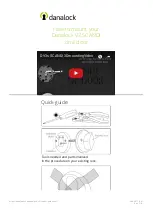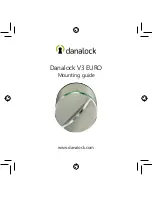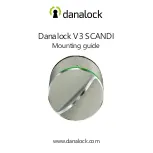
Page 11
6.4. Dip switch positions
In addition to running the necessary wires for the desired mode, positioning the three dip switches located on the
lock printed circuit board determines the operation. These are accessed by removing the cover.
MARKINGS S1, S2 AND M ARE FOUND ON THE PRINTED CIRCUIT BOARD.
Switches S1
and
S2
are used to set the timed re-lock. If an unlock signal is given to the lock but the door is not
opened the YD25 can automatically lock itself again after a selected time. This ensures that a door cannot be left
unsecured if it has been unlocked but not opened. The timer is factory set to 9 seconds but 0, 3 and 6 second options
are offered and selected by positioning the dip switches accordingly.
Switch M
is used to select fail safe or fail secure mode.
This is factory set as ordered and the only time it will
need to be moved is when operating a fail-safe lock in the two wire mode.
TIMED RELOCK
0 second
3 second
6 second
9 seconds - default
SWITCH POSITIONS
S1 On & S2 On
S1 Off & S2 On
S1 On & S2 Off
S1 Off & S2 Off
MODE
Fail Safe
Fail Secure
3 WIRE MODE
M Off
M On
2 WIRE MODE
M On
M On
7. OPERATION
7.1. Three wire mode (Recommended)
In either fail safe or fail secure configuration, maintained
connection of ‘1’ to ‘2’ will keep the YD25 unlocked
regardless of the door position. The following scenarios assume that the control signal is open at the start of the
operation sequence as a maintained connection will cause the lock to stay unlocked indefinitely.
7.1.1. Fail safe operation
Assume the door is closed and locked. M
omentarily connecting ‘1’ and ‘2’ unlocks the door for a period of 9 seconds*.
After the 9 seconds has elapsed if the door has not been opened the YD25 automatically locks again. If the door has
opened within the 9 second window (which is the case in normal operation) the timed re-lock is overridden and
automatic relocking occurs as soon as the door is closed. On closing, full power is applied to the YD25 9 times in 15
seconds before the current is reduced and the lock goes into a holding mode to minimize heating and power
consumption. The YD25 will remain unlocked as long as the door is open.
7.1.2. Fail secure operation
Assume the door is closed and locked. M
omentarily connecting ‘1’ and ‘2’ unlocks the door and over a 9 second
period full power is applied to the lock 5 times. If the door remains closed, after 9 seconds* has elapsed the YD25
automatically locks again. If the door has opened within the 9 second window (which is the case in normal operation)
the YD25 will remain unlocked and in a holding mode until the door is closed again and automatic re-locking occurs.
7.2. Two wire mode
In installations where running three wires to the lock is not possible or desired the YD25 can operate effectively on
two wires. Although the functions are reduced, as seen in the table below, controlling the lock this way still offers a
high security locking solution.
FEATURES
Multiple re-lock
(fail safe)
Multiple unlock
(fail secure)
Auto re-lock
Anti-Tamper
Adjustable timed
re-lock
3 WIRE MODE
Yes 9x
Yes 5x
Yes
Yes
Yes
2 WIRE MODE
Yes 5x
Yes 5x
Fail safe only
Yes
No






























